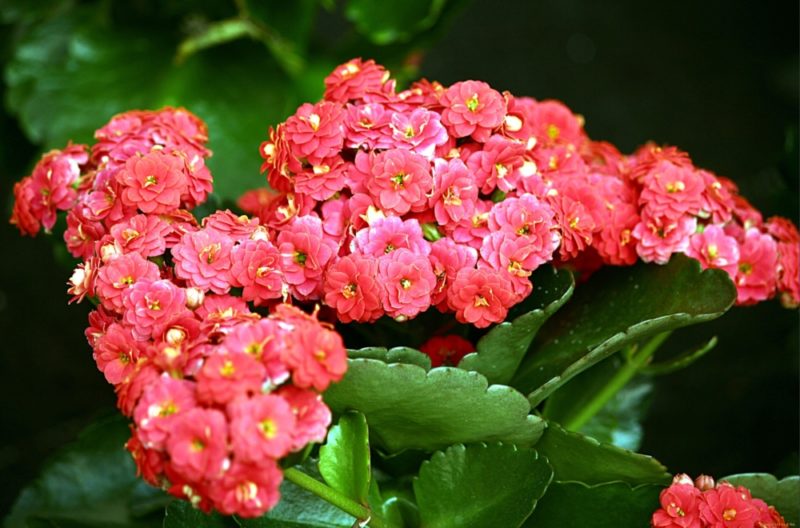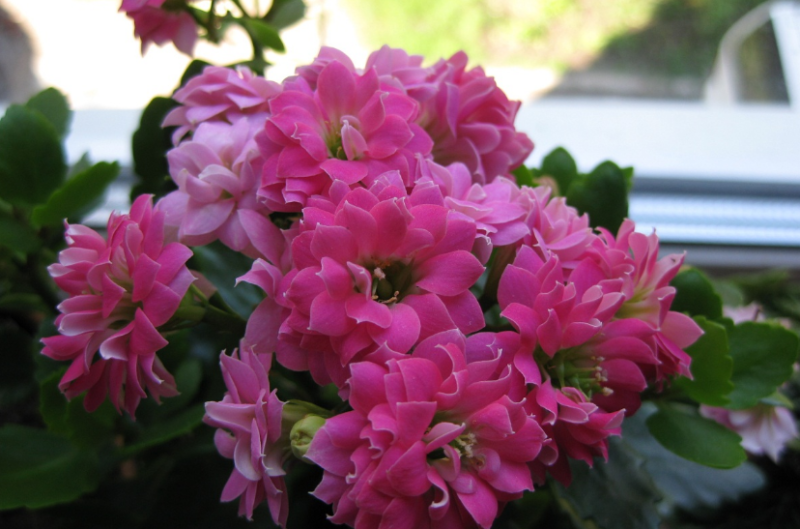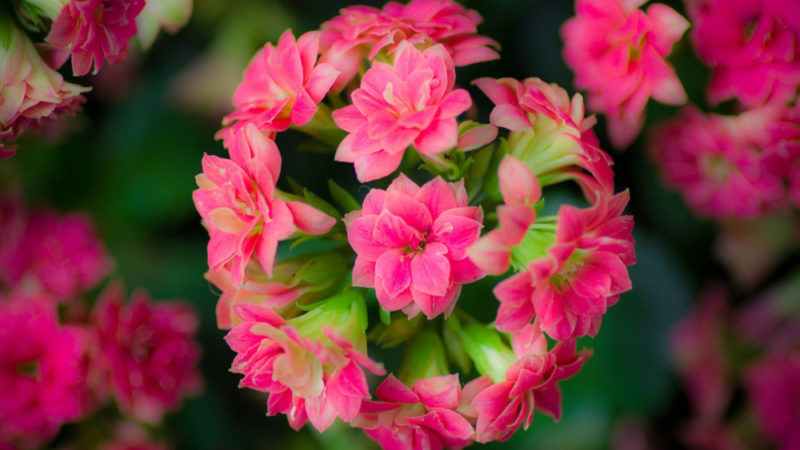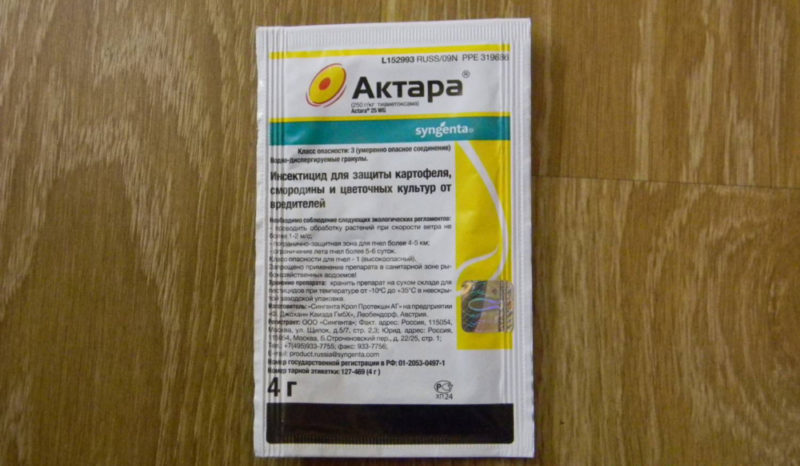Bright inflorescences surrounded by fleshy dark green leaves appear with good care, proper lighting. Growing a flowering Kalanchoe is easy if you follow the recommendations of specialists. Hardy succulent buds usually bloom in winter when other indoor plants have a dormant period.
Material Content:
Basic requirements for growing Kalanchoe
Various species of the Kalanchoe genus are cultivated as decorative foliage or flowering houseplants. The second group belongs to K. Blossfeld with flowers of red, orange, pink, yellow color. The natural appearance has four-petalled corollas, and the varieties “Kalandiva”, “Rosalina”, “Grandiva” which have become incredibly popular are terry flowers resembling tiny roses, as in the photo.
Other flowering species of the Kalanchoe genus (K. Mangini, cirrus, dissected, large-flowered, paniculate, Fedchenko, felt) are grown much less frequently.
When they begin to breed Blossfeld Kalanchoe at home, they often wonder about stimulating flowering. Indeed, in the store they buy pots with compact bushes, “caps” of bright flowers, behind which the leaves are barely visible. It should be remembered that plants in this form are brought from greenhouses and greenhouses, where they create the necessary conditions, “stuffed” with various biostimulants, inhibitors and other drugs.
After a change of scenery, in a room with a different temperature, watering, insufficient or excessive lighting, the buds do not develop.
The main reasons why Kalanchoe does not bloom in the room:
- expiration of fertilizers added during planting, the means that were processed to stimulate growth and budding;
- drastic changes in conditions of detention (after buying a flower in a specialized store);
- a change of place in the same room (when the owner turns and rearranges the pot of Kalanchoe);
- strong compaction of the root coma, desiccation or decay of the roots;
- Too frequent or insufficient watering.
It is recommended to take care of bought or donated plants without fanaticism. Kalanchoe in summer is kept at 22 - 26 ° C, in winter - at least 16 ° C (as in native Madagascar). Watering depends on the season, the condition of the leaves. Kalanchoe tolerates short drought more easily than waterlogging and waterlogging of the soil. Better to underfill than to overfill.
Decorative-deciduous and medicinal Kalanchoe Degremon - a plant up to 50 cm tall with one bare stem and long narrow-ovate serrated leaves along the edge. The species is easily recognizable thanks to brood buds from which small copies of the mother plant develop.
Kalanchoe Degremon blooms in adulthood. Small pink "bells" are collected in the apical inflorescence panicle. The juice of the leaves of this species, as well as pinnate Kalanchoe, is used in folk medicine as an anti-inflammatory agent.
Proper plant care at home
Kalanchoe Blossfeld and other species of this genus are succulents. Plants come from tropical and subequatorial Africa, eastern and central regions of Madagascar, where little rainfall occurs. Air temperature even in winter is not lower than 16 degrees Celsius, and in summer it rises to 35 ° C.
Ground and pot requirements
Kalanchoe needs a slightly acidic or neutral substrate. The soil must be water and breathable. These qualities provide good drainage at the bottom, adding sand and peat to the soil mixture.
Kalanchoe is transplanted into fresh soil, having previously cleaned the roots of the old soil (carefully so as not to damage). Water, cover from above with a plastic bag, which is removed daily for ventilation.
Kalanchoe in the new room is not immediately put on the windowsill. The flower takes some time to acclimatize.
A young plant is transplanted annually, an adult - in a year. The diameter of the pot should be 1 - 2 cm wider than the previous container. Large washed gravel or expanded clay is poured to the bottom so that the layer covers the drain hole. Small pieces of polystyrene can be used as drainage material.
Soil for succulents with already specified properties can be purchased at a supermarket or flower shop. If there is a universal substrate, then it should be mixed with ¼ large washed sand. Another option: add an equal volume of perlite or quartz sand to the soil for cacti.
Watering, fertilizing and fertilizing
Kalanchoe is a thrifty plant, it accumulates moisture in fleshy leaves, and survives in the dry period. In winter, it is enough to water the flower once a week. First you need to check the condition of the soil in the pot to a depth of 1 - 2 cm. The soil should be dry.
Use soft water for irrigation, ideally rain.
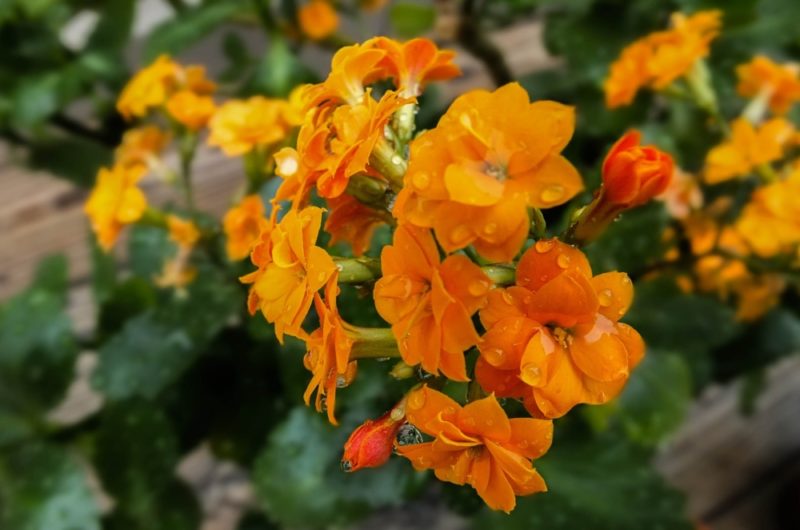 Watering from spring to autumn is required more often if it is hot and dry. Just like in winter, check the topsoil. Pour such a volume to evenly moisten the soil to a depth of 10 cm. Do not allow stagnation of water in the pan.
Watering from spring to autumn is required more often if it is hot and dry. Just like in winter, check the topsoil. Pour such a volume to evenly moisten the soil to a depth of 10 cm. Do not allow stagnation of water in the pan.
Kalanchoe is fed from April to October with a fertilizer solution for cacti (succulents). In winter, the plant does not need a lot of nutrients. With an annual transplant and the addition of fertilizer to the soil, fertilizing is not required.
Location, lighting and humidity
The light should be bright, diffused. The direct rays of the sun quickly dry out the soil in a small pot, the leaves burn out, the petals get burned. The best place for Kalanchoe Blossfeld - window sills of eastern and western orientation.In the summer at noon, shading is required.
Varieties of Kalanchoe Blossfeld with large terry corollas for flowering especially need good lighting.
Unlike most other flowering indoor plants, Kalanchoe tolerates dry air. You can occasionally spray the leaves to maintain a decorative look, dust removal.
Tips for Making Kalanchoe Bloom Every Year
Prior to budding, Kalanchoe provides a cooler content compared to the summer months. The ideal temperature is 13 - 16 ° C. Such conditions in the homeland of Kalanchoe at the end of summer, when it becomes cooler and shortens the day.
Lighting for 7 - 9 hours from November to February stimulates the flowering of the plant.
Kalanchoe Blossfeld, not belonging to the modern variety series, can be kept year-round at room temperature. In Europe, this indoor flower was called "Flaming Katie." Its simple corollas can bloom all year almost without a break. They are smaller than in modern varieties, up to 1 cm in diameter, red-orange in color. Varieties of "Kalandiva" and "Rosalina" are more demanding of light and temperature.
How to make Kalanchoe blossom:
- For laying flower buds, the plant provides a dormant period with a cooler content and sparse watering.
- It is necessary that the Kalanchoe is illuminated for about 8 to 10 weeks for no more than 9 hours, for the rest of the day the indoor flower is covered with an opaque box. In practice, this technique is carried out as follows: from 18 o’clock in the dark, from 9 o'clock in the light.
- The buds bloom in a short day, but even at this time of the year the light should be bright, watering should be moderate, air should be cool (16 ° C).
Often, Kalanchoe Blossfeld does not bloom and stretches. Flower buds are not laid due to errors in the care of the plant. An increase in internodes and stretching of the stem most often occurs with a lack of light with a simultaneous excess of moisture, a lack of nutrition. With an excess of fertilizers, the vegetative organs are lush, but flowering does not occur.
To return the decorative look, pruning and (or) transplanting of Kalanchoe to a height of 2 - 3 cm above ground level is needed. It is important that there is a thickening on the stem (“eye”). After flowering in spring or early summer, it is recommended to trim the upper part of the Kalanchoe with wilted peduncles. Lateral shoots that begin to develop from the kidneys can be pinched for better branching.
Pests, diseases and treatments
Kalanchoe is most often harmed by a spider mite, mealybug, whitefly, thrips. The insects are washed off the leaves with a stream of water, wiped with cotton wool moistened with a soap-alcohol solution. For spraying use drugs "Actara" or "Actellik" (insecticides).
Common diseases are of fungal origin. The infected shoots are removed, Kalanchoe is transplanted into fresh, disinfected soil. The plant is well restored after damage. Spraying with fungicides is required for severe infection. In general, Kalanchoe is resistant to disease and pests.


